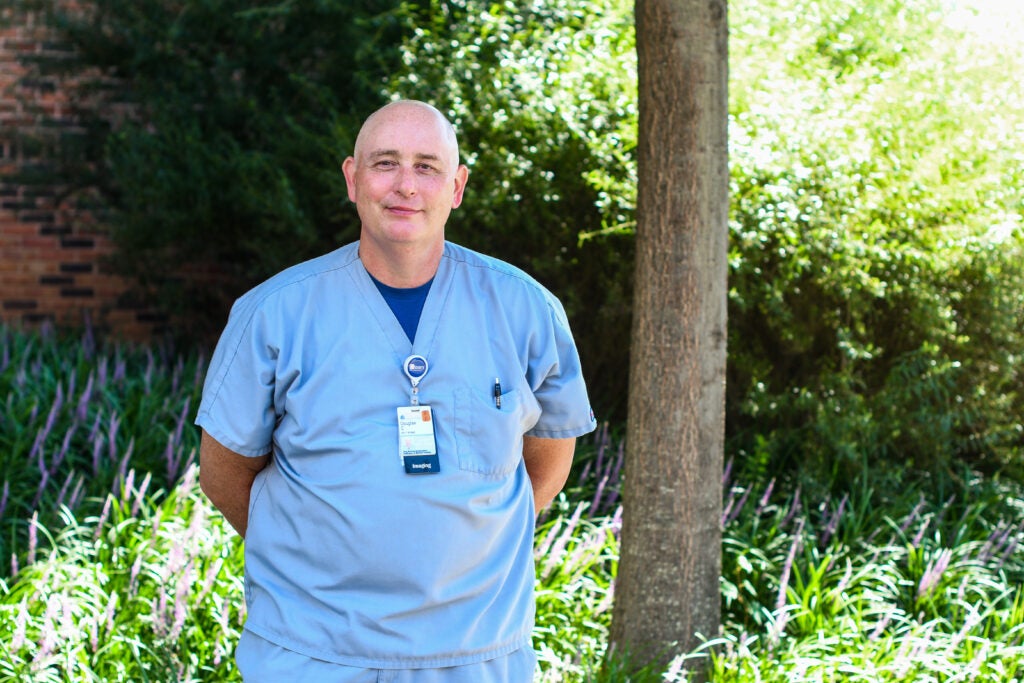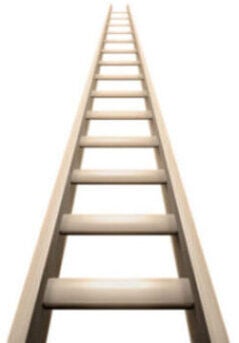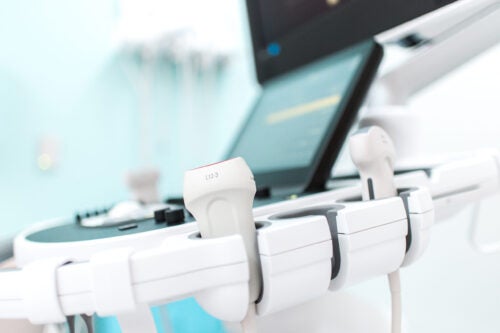
UVA Radiology sonographer Doug Catalano
In the fall of 2020, a new ultrasound clinical ladder was implemented at UVA Health. This new ladder has four steps, giving ultrasonographers at UVA a path to career advancement, more specialized training and additional leadership responsibilities, as well as corresponding rewards and recognition.
Doug Catalano, Sonographer IV in the general ultrasound lab, was the first ultrasonographer at UVA Health to ascend and complete all four levels of the ultrasound clinical ladder. We sat down with Doug to talk about his journey up the ladder, what others can expect when they challenge for a level, and why he feels pursuing the ladder makes a difference for both sonographers and patients.
Tell us about your journey to ultrasound and your current role at UVA Health.
Prior to coming to UVA, I worked for a corporation in northern Virginia that produced high-end outdoor furniture. I had a friend who was a diagnostic technologist who suggested I might like a career in medical imaging, too. I did some research and shadowing and decided to choose ultrasound. I applied for and was accepted into the very first ultrasound class at Piedmont Valley Community College and started on my Associate’s degree.
I started at UVA over 10 years ago, splitting my time between UVA Medical Center and Culpeper Regional Hospital. Within a year UVA hired me on a full-time basis. I work in the general lab in the main hospital, where we image inpatients as well as emergency room patients. We perform a pretty wide variety of ultrasound exams—more types of exams than the other ultrasound labs here, but we’re also much less specialized than they are. We’re like a one-stop shop.
How did you decide to try and climb the clinical ladder?

When the ladder program officially started in the summer of 2020, my supervisor at the time recommended that myself and another colleague challenge for level 3. That was mostly due to the fact that we both have Bachelor’s degrees, which is currently one of the requirements to advance beyond level 2.
I was excited because, at the time, there wasn’t a way to advance beyond your initial hiring level. So you were more or less stuck in your same position. Now new hires come in as a level 1, unless they have extensive prior experience in which case they can start as a level 2. But that’s very rare. If you pass your probationary period as a new hire and demonstrate proficiency in 90% of exams we perform, you become a level 2. But anything beyond level 2 requires you to specifically challenge and go through the ladder process. That’s where the real work begins.
Talk us through the process of challenging a step.
When you decide you want to challenge and ascend a level, you have to meet with your supervisor and agree on certain goals that need to be met and documented. There is also at least one large project that you have to accomplish for each level, something that benefits the entire department. You have one year to complete each challenge after officially submitting a letter of intent to the board. That year can go by very quickly!
One of my projects was to look at all the IMG codes that imaging uses and confirm which ones needed to be discontinued. This was to help prevent ordering physicians from using defunct codes and save everyone a lot of time and confusion. Another was to start ultrasound training for first-year radiology residents, to help them learn how to optimize images and use the machine effectively.
Once you’ve finished your project and your goals, you create a portfolio with all the documentation and self-scoring you need, as well as a resume, registries that you have passed and two endorsements. You want to make sure that when it goes to the clinical ladder board, your portfolio will generate enough points to justify being moved up to the next level.
Points can be subjective, but they give the board a big-picture sense of what you’ve done in a year. That’s where documentation comes in—you can’t just say “I did this” and give yourself a score— you have to prove you accomplished it with documentation. You have to treat it almost like you’re presenting a case to a jury and include every possible detail that you can to justify your rationale for moving up a level.
When did you complete levels 3 and 4 and gain approval from the board?
In the summer of 2020 I started working towards level 3. I didn’t complete that work and get approved by the board until summer 2021. I started working on level 4 in July 2021 and was approved in August 2022.
I actually serve on the clinical ladder board myself, alongside members of the Department of Radiology’s leadership team, technologists from each modality (nominated by their supervisors for two-year terms), and representatives from other departments. Being on the board was my primary motivation to do the ladder in the first place—I was nominated to be on the board, and I decided that if I was going to be passing judgment on others doing this, I wanted to go through the process myself, so I would be a more objective judge of work that needs to be done.
What would you say to other sonographers who are interested in challenging a level on the clinical ladder?

The first obvious personal benefit is the pay increase, which you receive at both level 3 and level 4.
But you should also expect to be given more of a leadership role, which is a major point of the ladder—self-betterment and creation of leadership and mentorship roles within the department. I enjoy leadership and mentorship roles, and the clinical ladder helps codify that and lets you guide others in a more official way.
To me, the ladder also directly affects patient care. Ultrasound is a completely operator-dependent modality, so the additional knowledge and expertise you gain are critical, especially in the inpatient setting with very sick patients. We are acting as the eyes of the radiologist, providing them with the imaging they need for a good diagnosis.
I know there is a lot to digest in the clinical ladder guiding document. So folks who’ve gone through the process are meant to help mentor people who are interested and help lead them through it. It can be pretty daunting, but I can help others manage their time and give them a realistic idea of what kind of commitment in time and effort is required to do this. It’s pretty significant. But anything we can do to give people who have come here, stayed here and put in hard work a pathway to advancement and leadership is a good thing.
To learn more about the Ultrasound Clinical Ladder, click here (note: link is only accessible to UVA employees).

Comments